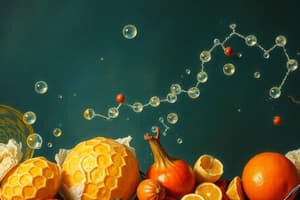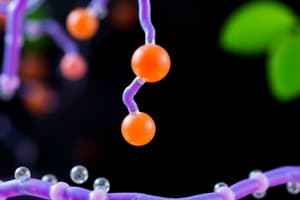Podcast
Questions and Answers
What is a key characteristic that differentiates homopolysaccharides from heteropolysaccharides?
What is a key characteristic that differentiates homopolysaccharides from heteropolysaccharides?
- Length of their chains
- Type of bonds linking their monosaccharide units
- Number of types of monosaccharide units (correct)
- Degree of branching
Which polysaccharide serves as a storage form of fuel in plants?
Which polysaccharide serves as a storage form of fuel in plants?
- Starch (correct)
- Cellulose
- Glycogen
- Hyaluronic acid
Where is glycogen primarily stored in the animal body?
Where is glycogen primarily stored in the animal body?
- Liver and muscle cells (correct)
- Red blood cells
- Fat cells
- Brain cells
What is the main structural polysaccharide found in plant cell walls?
What is the main structural polysaccharide found in plant cell walls?
What is the primary location of glycolysis in the cell?
What is the primary location of glycolysis in the cell?
What function does hyaluronic acid serve in the body?
What function does hyaluronic acid serve in the body?
Which of the following is an inhibitor of glycolysis?
Which of the following is an inhibitor of glycolysis?
What are the net products of glycolysis from one molecule of glucose?
What are the net products of glycolysis from one molecule of glucose?
During which condition does gluconeogenesis primarily occur?
During which condition does gluconeogenesis primarily occur?
Which of the following is NOT a gluconeogenic precursor?
Which of the following is NOT a gluconeogenic precursor?
What is the empirical formula of carbohydrates?
What is the empirical formula of carbohydrates?
Which of the following describes monosaccharides?
Which of the following describes monosaccharides?
What is the primary role of the Cori cycle?
What is the primary role of the Cori cycle?
Which of the following statements about gluconeogenesis is true?
Which of the following statements about gluconeogenesis is true?
What distinguishes aldoses from ketoses?
What distinguishes aldoses from ketoses?
What triggers glycogen breakdown in skeletal muscle?
What triggers glycogen breakdown in skeletal muscle?
Which of the following is an example of a disaccharide?
Which of the following is an example of a disaccharide?
Oligosaccharides consist of how many monosaccharides?
Oligosaccharides consist of how many monosaccharides?
What is the function of glycogen stored in the liver?
What is the function of glycogen stored in the liver?
Which classification of carbohydrates consists of only one type of monomer?
Which classification of carbohydrates consists of only one type of monomer?
Which pathway is activated after a meal to store glucose as glycogen?
Which pathway is activated after a meal to store glucose as glycogen?
During fasting, what process helps maintain blood glucose levels?
During fasting, what process helps maintain blood glucose levels?
Which of the following represents a carbohydrate with a ketone group?
Which of the following represents a carbohydrate with a ketone group?
What type of metabolic pathway is glycogenolysis?
What type of metabolic pathway is glycogenolysis?
Which type of monosaccharide has four carbon atoms?
Which type of monosaccharide has four carbon atoms?
Which of the following accurately describes glucagon's role in carbohydrate metabolism?
Which of the following accurately describes glucagon's role in carbohydrate metabolism?
Flashcards
Homopolysaccharide
Homopolysaccharide
A polysaccharide made up of only one type of monosaccharide.
Heteropolysaccharide
Heteropolysaccharide
A polysaccharide composed of more than one type of monosaccharide.
Starch
Starch
A branched polymer of glucose molecules found in plants, mainly stored in seeds and tubers.
Glycogen
Glycogen
Signup and view all the flashcards
Cellulose
Cellulose
Signup and view all the flashcards
Hydrosoluble Carbohydrates
Hydrosoluble Carbohydrates
Signup and view all the flashcards
Monosaccharides
Monosaccharides
Signup and view all the flashcards
Aldoses and Ketoses
Aldoses and Ketoses
Signup and view all the flashcards
Trioses, Tetroses, Pentoses, Hexoses
Trioses, Tetroses, Pentoses, Hexoses
Signup and view all the flashcards
Disaccharides
Disaccharides
Signup and view all the flashcards
Polysaccharides
Polysaccharides
Signup and view all the flashcards
Glycolysis
Glycolysis
Signup and view all the flashcards
Glycolysis phases
Glycolysis phases
Signup and view all the flashcards
Gluconeogenesis
Gluconeogenesis
Signup and view all the flashcards
Glycolysis regulation
Glycolysis regulation
Signup and view all the flashcards
Gluconeogenesis function
Gluconeogenesis function
Signup and view all the flashcards
Cori Cycle
Cori Cycle
Signup and view all the flashcards
Glycogenolysis
Glycogenolysis
Signup and view all the flashcards
Glycogenesis
Glycogenesis
Signup and view all the flashcards
Regulation of Carbohydrate Metabolism
Regulation of Carbohydrate Metabolism
Signup and view all the flashcards
Well-fed state
Well-fed state
Signup and view all the flashcards
Fasting state
Fasting state
Signup and view all the flashcards
Study Notes
Carbohydrate Metabolism
- Carbohydrates are hydrosoluble molecules with the empirical formula (CH₂O)ₙ.
- Monosaccharides (simple sugars) are the building blocks of larger carbohydrates.
- Aldoses have an aldehyde group, ketoses have a ketone group.
- Monosaccharides can be classified based on the number of carbons (trioses, tetroses, pentoses, hexoses) and their functional group (aldoses, ketoses). Examples include glucose, fructose, galactose, and ribose.
- Oligosaccharides are formed by the linkage of 2-10 monosaccharides via glycosidic bonds. Maltose is an example of a disaccharide (2 monosaccharides). Sucrose and lactose are also disaccharides.
- Polysaccharides are formed by more than 10 monosaccharides linked by glycosidic bonds. They differ in the identity of the repeating units, the length of chains, the type of bonds, and the degree of branching. Examples include starch and glycogen (both glucose polymers).
- Starch is a branched polymer found in plants, glycogen is a branched glucose polymer in animals.
- Cellulose is a structural polysaccharide in plants, unbranched polymer.
- Heteropolysaccharides contain more than one type of monosaccharide and include hyaluronic acid.
- Hyaluronic acid is found in synovial fluid for lubrication and in the vitreous humor of the eye for its jelly-like consistency
Glucose Homeostasis
- Glucose is an essential metabolic fuel for the brain and other tissues.
- Homeostasis ensures constant blood glucose levels.
- After a meal: Blood glucose rises, insulin released, glucose uptake stimulated, glycogen formation.
- During fasting: Blood glucose lowers, glucagon stimulates, glycogen breakdown, gluconeogenesis starts.
Glycolysis
- Glycolysis is the catabolic pathway of glucose breakdown into pyruvate.
- Glycolysis is a universal central pathway.
- Glycolysis occurs in the cytoplasm.
- Stages are preparatory and payoff phases, consuming 2 ATP and producing 2 ATP and 2 NADH.
Gluconeogenesis
- Gluconeogenesis is the biosynthesis of glucose from non-carbohydrate precursors like pyruvate, glycerol, lactate and some amino acids.
- It's an anabolic pathway, and largely takes place in the liver and sometimes the renal cortex.
- It's important during fasting and after exercise to provide glucose.
- Gluconeogenesis bypasses the 3 irreversible steps of glycolysis via different enzymes.
- Requires 4 ATP and 2 GTP per glucose molecule formed from pyruvate.
Cori Cycle
- The Cori cycle describes the metabolic pathway that converts lactate from muscle tissues into glucose in the liver.
- During intense exercise, lactate produced in muscles is transported to the liver.
- In the liver, lactate is converted back to glucose, which is returned to the muscles for use.
Glycogen Metabolism
- Glycogen is a highly branched polysaccharide, the storage form of glucose in animals.
- Glycogenolysis is the breakdown of glycogen to glucose for energy. Activated by epinephrine or glucagon.
- Glycogenesis is the process of converting glucose to glycogen to be stored. Insulin activates the process.
- Glycogen in muscles is important for muscle contraction, in liver for blood glucose homeostasis.
Regulation of Carbohydrate Metabolism
- Regulation of carbohydrate metabolism involves various hormones such as insulin, glucagon, and adrenaline, along with differing states of energy availability.
- During well-fed state: Insulin released, glucose increases, glycogen synthesis, glycolysis.
- During fasting state: Glucose decreases, glucagon released, glycogen breakdown, gluconeogenesis.
Studying That Suits You
Use AI to generate personalized quizzes and flashcards to suit your learning preferences.




